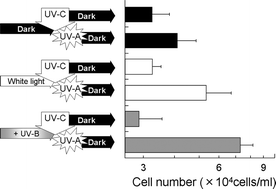Phytoplankton such as Euglena are constantly exposed to solar light which is used for photosynthesis. Although the solar ultraviolet (UV) induces DNA damage such as cyclobutane-pyrimidine dimers (CPDs), many kinds of living organisms can repair CPDs by photoreactivation (PR) utilizing the near-UV/blue light component in sunlight. Euglena cells are known to possess such PR activity. In the present paper, the formation of CPDs induced by UV-C exposure and the photoreactivation PR repair of these CPDs by UV-A are demonstrated. To clarify the adaptive responses prior UV-B irradiation on PR activity, cells were cultured in the dark or under UV-B light. When the cells were cultured in the dark for 3 d prior to UV-C exposure, PR activity decreased. When the cells were cultured under UV-B light, however, PR activity increased. These results suggest that exposing the cells to UV-B prior to exposure to UV-C induced an adaptive response towards DNA damage caused by UV-C exposure, and this UV-C induced damage was repaired through PR activity.

You have access to this article
 Please wait while we load your content...
Something went wrong. Try again?
Please wait while we load your content...
Something went wrong. Try again?


 Please wait while we load your content...
Please wait while we load your content...